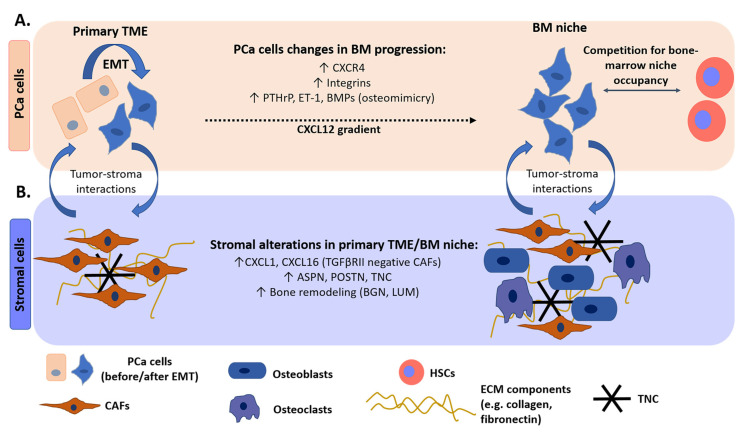Figure 3.
Main components and similarities between primary PCa and bone metastatic stroma. (A) Changes occur in PCa cells during bone metastasis (BM) progression. PCa cells undergo EMT to acquire an invasive phenotype and express CXCR4 receptor to become sensitive to CXCL12 gradient and migrate towards the bone. They also express integrins to adhere to collagen fibers and enter the bone-marrow niche, in which they compete with hematopoietic stem cells (HSCs) for niche occupancy (since HSC homing to the bone marrow niche is also CXCL12-dependent). To modify the behavior of resident bone cells (mainly osteoblasts and osteoclasts), PCa cells release factors typically produced by osteoblasts as parathyroid hormone related peptide (PTHrP), endothelin (ET-1), and bone morphogenetic proteins (BMPs) (osteomimicry). (B) Reactive stroma of primary high-grade tumors shares similarities with BM stroma, probably because PCa cells acquire osteomimicry already in the primary tumor, affecting stromal cell behavior. A population of TGFβRII-negative CAFs is found in both tumor sites, secreting cytokines CXCL1 and CXCL16 that favor PCa cell establishment in the BM niche. CAFs in both primary PCa and BM also express ASPN, POSTN, and TNC, highlighting the similarities between the two microenvironments. TNC expression in the BM niche may favor the adhesion of disseminated PCa cells. Moreover, expression of bone remodeling proteins biglycan (BGN) and lumican (LUM) is also detected in primary PCa stroma of high-grade tumors compared to low-grade or benign stroma.

